Grooming your cat is essential not only for keeping them looking their best but also for maintaining their overall health. Here are the top 10 tips to help you groom your cat like a pro!
1. Start Early and Make It Routine
Getting your cat accustomed to grooming early will make the process much easier as they grow older. Kittens can be more adaptable to new experiences, so the sooner you start, the better. Even for older cats, introducing grooming gradually and making it a regular part of their routine will help minimize stress.
Pro Tip: Make grooming sessions short and sweet in the beginning, offering treats and gentle praise.
2. Choose the Right Tools
The right grooming tools can make a world of difference. Long-haired cats may need a wide-tooth comb and a slicker brush to keep tangles at bay, while short-haired cats benefit from a grooming mitt or a soft bristle brush. Don’t forget nail clippers and specialized combs for shedding seasons.
Pro Tip: Invest in a deshedding tool, especially during the shedding season, to minimize loose fur and hairballs.
3. Brush Regularly to Prevent Matting
Brushing your cat’s coat regularly, especially if they have long hair, helps prevent tangles and mats, which can be painful for your cat. For short-haired cats, brushing helps reduce shedding and hairballs. Aim to brush long-haired cats daily and short-haired cats a few times a week.
Pro Tip: Focus on areas prone to matting, like the belly, underarms, and behind the ears.
4. Bathe Only When Necessary
Unlike dogs, cats groom themselves, so they usually don’t need frequent baths. However, if your cat gets into something dirty or has a skin condition, a bath might be necessary. Use a gentle, cat-specific shampoo and ensure the water is warm (not hot).
Pro Tip: If your cat is unfamiliar with baths, ease them in by placing them in an empty tub and letting them get comfortable before adding any water.
5. Trim Nails Safely and Regularly
Keeping your cat’s nails trimmed prevents overgrowth, splitting, and potential injury to both your cat and your furniture. Use cat-specific nail clippers, and make sure you only trim the sharp tip of the nail, avoiding the quick (the sensitive pink part).
Pro Tip: If you’re unsure about trimming the nails yourself, ask your vet or groomer to demonstrate the first time.
6. Clean Their Ears Gently
Cats are generally good at keeping their ears clean, but it’s still important to check them regularly for dirt, wax, or signs of infection. Use a damp cotton ball or a vet-approved ear cleaner to wipe the outer part of the ear.
Pro Tip: Never insert anything into the ear canal. If you notice excessive wax, foul odors, or redness, consult your vet.
7. Tackle Tear Stains
Some cats, particularly those with light-colored fur or flat faces (like Persians), may develop tear stains under their eyes. To clean these stains, use a damp cotton ball or a soft cloth. Avoid harsh chemicals—plain water or a vet-recommended tear stain remover will do the trick.
Pro Tip: Wipe tear stains daily to prevent buildup and staining.
8. Monitor for Fleas and Ticks
Regular grooming is a great opportunity to check for fleas, ticks, or other skin problems. Run a fine-tooth flea comb through your cat’s fur, particularly around the neck and tail. If you notice small black specks (flea dirt) or actual fleas, consult your vet for treatment.
Pro Tip: Use flea prevention treatments recommended by your vet to minimize infestations.
9. Keep an Eye on Their Skin and Coat Health
A shiny, soft coat usually indicates a healthy cat. If you notice dandruff, bald spots, excessive shedding, or skin redness, it could be a sign of underlying health issues. Grooming sessions are a good time to assess your cat’s overall health.
Pro Tip: Introduce omega-3 fatty acids (consult your vet) into your cat’s diet to promote coat health and reduce shedding.
10. Keep Calm and Create a Positive Experience
Cats can sense tension, so staying calm and patient during grooming sessions is essential. Use a soothing voice, and if your cat gets anxious, take breaks and reward them with treats or playtime afterward.
Pro Tip: Make grooming enjoyable by incorporating bonding time with your cat. Gentle brushing or massages can help strengthen your relationship.
By following these tips, you can ensure your cat stays clean, healthy, and happy. Grooming also strengthens the bond between you and your cat, turning what could be a stressful chore into a relaxing routine for both of you.

